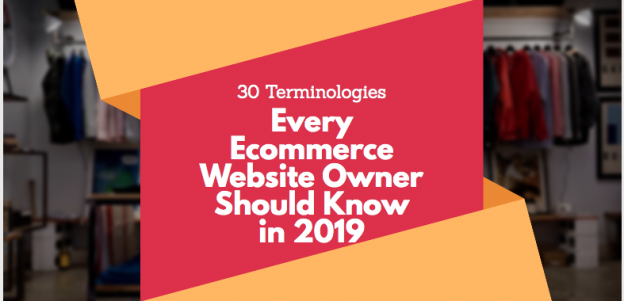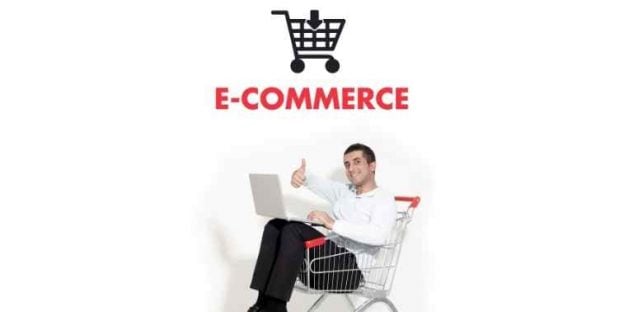30 Terminologies Every Ecommerce Website Owner Should Know in 2019

Sometimes dealing with an Ecommerce professional might leave you scrambling for a glossary. As a thriving online merchant, you should be well versed with the Ecommerce jargon not only to protect yourself from frauds but also to come with best possible strategies to run the business. Perhaps you wanted to drive organic traffic to your website but unaware of what ‘SEO’ means or you do not know what to do with ‘cookies’. Your marketer suddenly tells you that over 60% of shopping carts have experienced “Cart Abandonment” last month. SEO, cookies, Cart abandonment, Assisted conversion, Authorization, Bounce rate and there are many more in the list. But, you are not alone! We are listing out most of the important terms below whereas for additional assistance, feel free to write to us in the comment box.
1. 301 Redirect: It is a permanent redirection from one URL to another to send website visitors to a completely new URL than what they had typed originally in their browsers. There can be three major reasons behind why your marketer sets up 301 redirection. To associate common extensions like http://, www., etc. with 1 URL , to rename a website or to send traffic from one url to another.
2. Abandonment: If a user visits an ecommerce website and leaves without making any decision then it is called Abandonment. In most of the cases, Abandonment is related to Cart Abandonment where the user places items in the cart but leaves without purchasing them due to various reasons. Abandonment can have many types though, such as Shipping abandonment, Booking abandonment etc.
3. A/B Testing: A/B Testing is kind of check performed by Ecommerce website development companies to check which page performs better out of two pages. The one with high conversion rate is opted and other one is discarded. It is also called Split testing and not only with websites, it can also be used with emails.
4. Affiliate marketing: Affiliate marketing, a type of performance based marketing is an arrangement through which a company pays commission to people called affiliates in order to sell company’s products through their website or other marketing mediums. It is mostly favored by merchants as they do not have to pay until results are driven. Some of the companies use their own software programs to track the sales whereas some use external third party tools. Not only merchants but users are also showing their interest exceedingly in these kind of programs as it can be run a side job for some extra money in the pocket. It is a small four step procedure f0r anyone to become an affiliate. He/she has to Join the program> Pick a product> Share link via Blog, Social Media, Youtube or any other medium> Earn a commission.
5. API: API is Application programming interface is a software that allows two applications to interact with each other. It is a set of protocols or instructions to enable one application to expose services to some other application. The term would be generally used by the professional when they need any external services such as payment gateway, shipping etc. because those would be integrated through API. You have to get API from vendors that provide such services and give access to the developer. There can be many types of APIs used for development of an Ecommerce website.
6. Average Time on Site: Your web analytics report would show you the Average time on site. It is the time spent by a visitor on a web page. Though, your report would be often misleading as it is not possible to measure the actual time on site. When your web page is open in front of your users, it is not necessary that they are reading the page. They might indulge in their phones or some other activity. For example, if the time shown in the report is 10s for a long post of 4000 words then it is not possible that the user has read it actually. Average time on site is one of the important metrics to know as you will come to know if your content is engaging enough or not.
7. B2B: B2B is Business to Business model in which a business deal with another business in order to exchange products or services. It can be between manufacturer and wholesaler or wholesaler and retailer. B2B companies are the enterprises which generate offerings for other businesses such as a wholesaler if you are giving out your products to the retailer who is also a business person then it is a B2B deal. For example, the very famous alibaba.com is based on B2B concept where wholesalers sell out their products to the retailers.
8. B2C: B2C is Business to Consumer model where the business interact directly with end users or consumers for product/service exchange. Most of the Ecommerce website today are based on B2C model. For example, if you purchase any book from Amazon then it is a B2C deal where the person who wants to read the book is purchasing it directly from the seller. With the exponential rise of online purchasing, B2C models are immensely popular now. People prefer to buy products online rather than going to physical shops and hence Ecommerce website based on such models are on the verge of success with marketing and sales are strategized properly.
9. Bounce Rate: It is the percentage of visitors who leave your website from single page without visiting other pages. As per Google analytics, “Bounce Rate is the percentage of all sessions in which users visited only a single page without sending any other request to the Analytics server.” It is the term that you must have heard from your marketer because if your website has a high bounce rate then search engines do not prefer to show you on top positions means it is one of the most crucial factors when it comes to SEO.
10. Bundling: Bundling is a marketing strategy defined as grouping of similar or connected products and selling them as package solution. These packages are generally sold at a reduced cost to carry out the sale of more than one product.
11. Buyer’s persona: Buyer’s persona is prepared by taking into account various things such as behavioural patterns, demographics and goals of the user. It tells you about what your customers must be thinking about the services you provide while they weigh their options. The advanced term is actionable buyer persona which means revealing much more than a one dimensional profile. It might include several advanced analysis such as concerns, specific attitude and mediums that drive your prospects to choose you.
12. Call-to-action: Again often used by your website designer or marketer! Call-to-action are the words, phrases, links or buttons that prompt an immediate response to encourage users to buy your products. You will often see such buttons or links on any ecommerce website like “Buy Now”, “Click Here”, “Get 10% off today” or any such words that pique interest. These is one of the most important things to be included in your Ecommerce sales strategy since it helps users come down the sales funnel.
13. Chargebacks: Chargeback is one of the major concerns site owners have. It has been designed to protect cardholders against fraud in terms of products or services. If you own an online store, most of the payment would be done through credit cards on which chargeback might happen if they raise a valid dispute. So, you need to safeguard your website against invalid chargebacks. It is a buyer protection measure but sometimes it is misused. Suppose, you are selling a product in good condition, the buyer hurt it a little later and then apply for chargeback. The case would be closed in favor of the buyer since he/she has pictures to present.
14. Cohort analysis: Cohort analysis is a part of user behavioral analysis. It receives data from a defined data set instead of looking at all the visitors as 1 unit, it separates them into associated groups for analysis.
15. Conversion: You must have heard this term every now and then. Most of the people relate it with sales but conversion is a wider terms which takes into account all the desirable actions that a website wants you to do. Suppose, a website has set up a subscribe to newsletter campaign then the conversion happens if a user has successfully subscribed to the newsletter. If you own an ecommerce store then conversion can happen if the user buys a product, fill out a lead/contact form or sign up for a newsletter. Conversion is a positive factor which should always increase for an ecommerce store to have success in the market. There can be n number of ways to increase conversion including having a great UI, great content, proper call-to-action, competitive cost, good quality service/product and more to it.
16. Cookies: A cookie is a data generated by a website while anyone one is using it. It is generally of a little amount and is stored in the user’s computer i.e. client side. The purpose of cookies is to record your preferences and remember your information regarding a particular session.
17. Customer Lifetime Value: It is one of the important metrics for an ecommerce company which tells its owner about the Total net profit it would make out of the lifetime relationship with a particular customer. Depending upon this metric, you can predict the monetary value you will be receiving from a customer if you are able to make a long term relationship. You should consider CLV while measuring the success of any of your marketing campaigns. The profit is not just the difference between what you have received and what you had spent. It is sum of what those customers are going to contribute towards your business growth. Let’s suppose, you got a customer seeking for best Ecommerce development services, they might also take SEO, SMO, PPC or re-branding services from you. Additionally, you might get to handle their maintenance part which runs lifetime. This is the reason why CLV is an important metric while measuring ROI.
18. Click through Rate: Click through rate often called as CTR is the ratio of number of clicks to the total number of visitors viewing a particular page. CTR can be measured for a website, mail or advertisement. It is generally measured to see the effectiveness of a particular keyword, ad or mail. The higher the CTR, the more effective the campaign is considered. Whenever you send any email, it is aimed at getting more and more clicks so that users may know what it is all about. So, your CTR should go up but yes, it might affect you negatively in terms of paid marketing if not done carefully. Getting high CTR through wrong keywords might destroy your whole budget.
19. Dropshipping: Dropshipping is an eCommerce arrangement where the products are shipped from the manufacturer to customer or retailer directly. There is no need to store or stock items in this method.
20. Engagement Rate: It is the percentage of how many visitors came to the site, notice the content and could engage. It is generally measured to see if your content could help your target market or not. Factors influencing engagement rate include likes, shares and comments. If any of your post is getting a high number of shares and re-shares then it is going to increase the engagement rate which is good for your business.
21. Google analytics: It is a cost free analytics service offered by Google which can be linked to your website to track the traffic and provide other statistics useful for optimization of your website.
22. Hashtag: It is a word or phrase preceded by # highly used over social media sites to identify the messages connected with specific topics. While the customers use hashtags with posts over social media, the message attached to those posts get revealed. Also, clicking on those hashtags would take user to all posts with the same hashtag.
23. Key performance indicator: KPI is a value which measures the key business objective success. There are two types of KPIs. One is high level KPI dealing with the overall performance of the business whereas other is low level KPI looking at the processes such as marketing, sales, operations, etc.
24. Lead: Leads are defined as the interest shown by any of your prospects in your products or services. It generally contains the contact information to the user along with a small description of his/her requirement. It is followed by a call made by the salesperson of your company who gathers the requirements and suggest the required solution
25. Marketing automation: Marketing automation has taken over the whole digital market now. It is a set of various practices adopted by marketing agencies to automate the process of marketing so that the team does not have to invest much time in targeting every single prospect. It included optimum usage of a software to automate the process of marketing for effective results in terms of sales of your goods and services over various online channels.
26. Mobile optimization: Mobile optimization is a process which ensures that your visitors have great user experience while they use your website on mobile device of varied screen sizes. The content and all the important information along with categories and subcategories should fit in the screen so that you do not lose out on any of your customers.
27. Profit margins: Profit margins are calculated to know how well a company works on its input cost and revenue. It is defined as the % of the selling price turned into profit.
Profit Margin = (Total Sales – Total Expenses)/Total Sales
28. Point-of-sales: Point of Purchase or Point of Sale is a place where sales happen. It refers to a point when payment is actually made by customers to the merchant for the purchased goods/services.
29. ROI: ROI is Return on Investment which means the calculation of what you have received as return over the spending done.
ROI = (Net Profit / Cost of Investment) x 100
It refers to the gain or loss experienced by a company on the investment done in a particular period of time. It is an important metric for business owners to know so as to decide which path is beneficial to tread.
30. XML Sitemap: Sitemap is the hierarchical model of the content pages of a website. The list contains links to its counterparts of a site. These are formatted and organized in an XML format which is why these are called XML Sitemap.
Feel free to ask us about any other term you would like to get acquainted with in the comment section.









